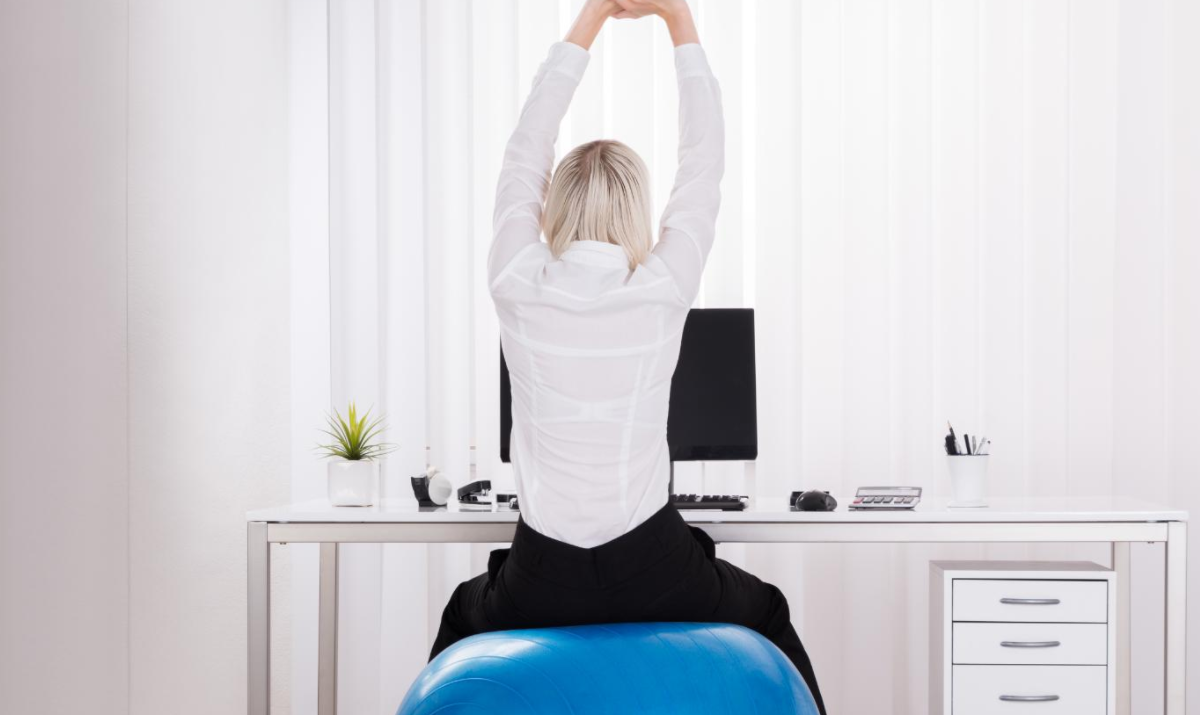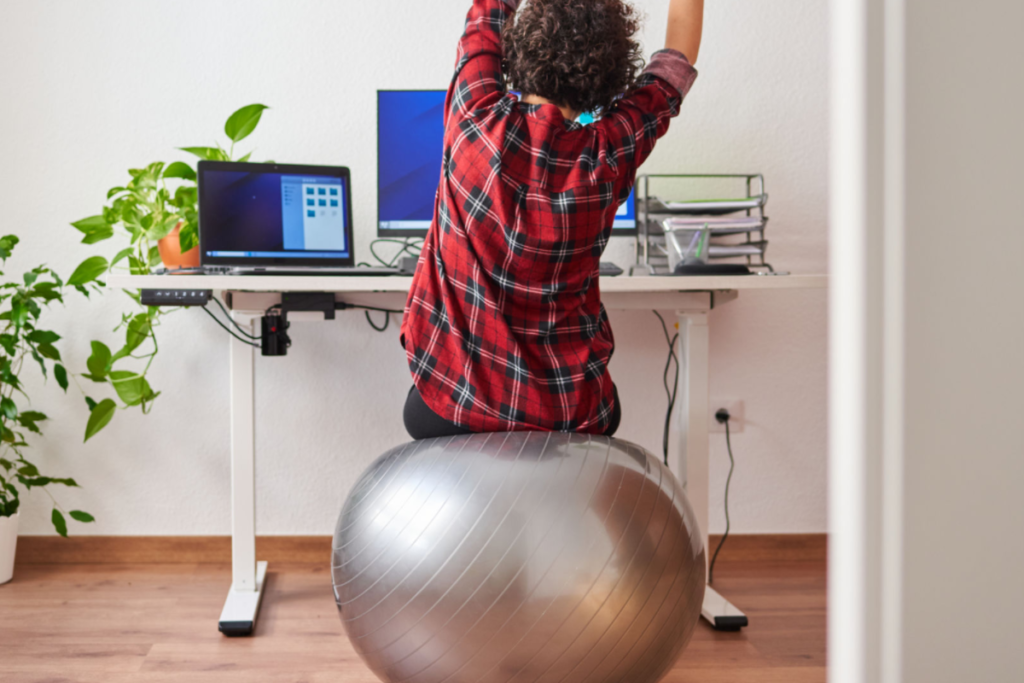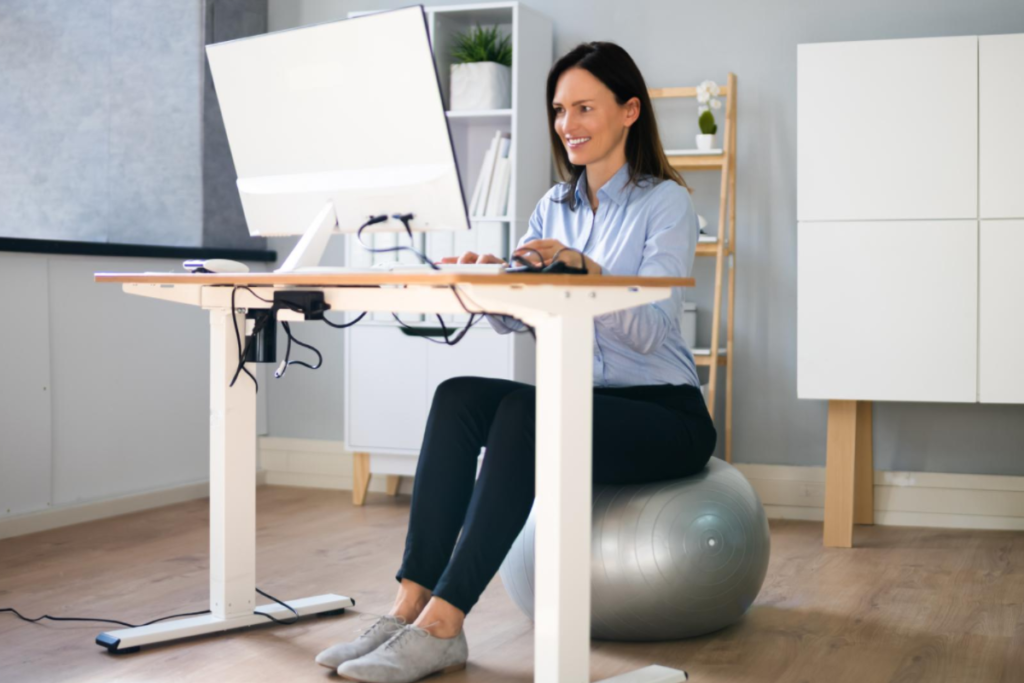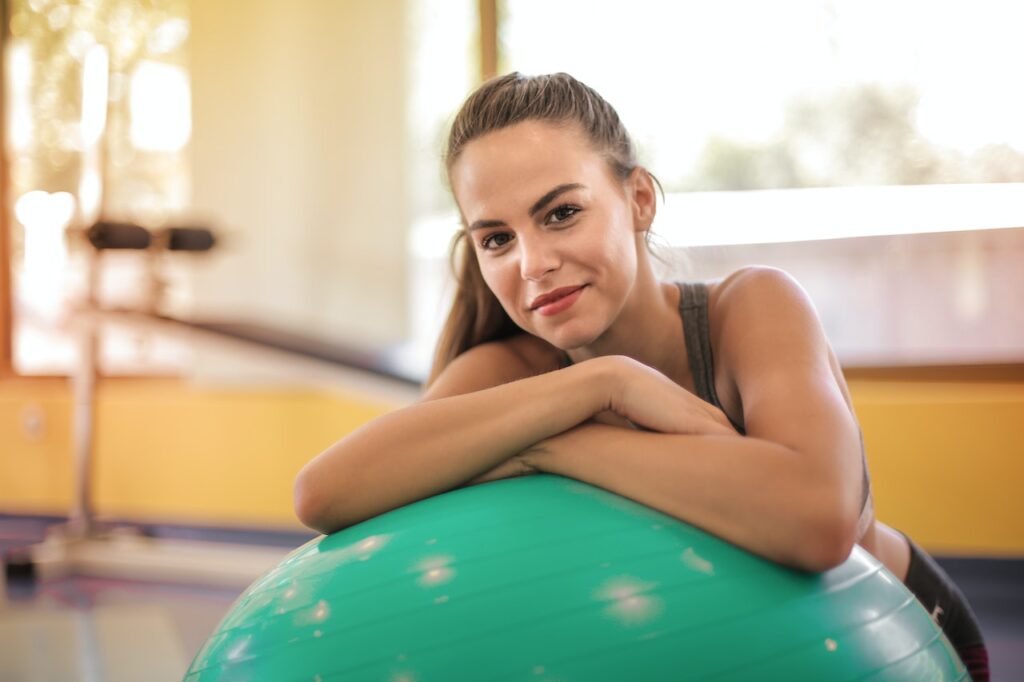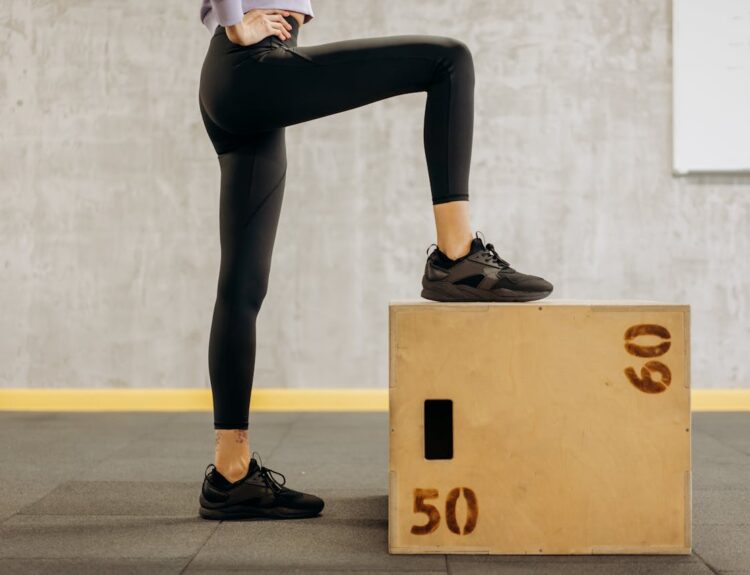Sitting on a balance ball at work is a trend that’s challenging traditional office seating. In an era where wellness and productivity intertwine, using a balance ball as an alternative to standard chairs has gained momentum. We can hear people saying that with the help of an exercise ball, they do their training while they are at work. But can this innovative seating strategy be classified as a form of exercise?
Is sitting on a balance ball at work the ultimate exercise hack or a wellness-inspired fad? Explore this unconventional approach to office seating.
In this article:
- The exercise ball seating trend
- Benefits of sitting on a balance ball at work
- Can sitting on a balance ball at work replace traditional exercise?
- Tips for integrating exercise with sitting on a balance ball at work
THE EXERCISE BALL SEATING TREND
In an era where workplace wellness is gaining prominence, the exercise ball seating trend has captured the attention of those seeking innovative ways to balance health and productivity. Transitioning from conventional office chairs to sitting on a balance ball is more than just a quirky change in seating; it’s a shift toward promoting active sitting. Realizing prolonged sedentary behavior can affect our overall well-being has sparked this trend. In response, employees and employers are exploring dynamic alternatives to traditional desk setups.
The exercise ball seating trend involves engaging core muscles and encouraging subtle movement while working. These inflatable spheres, often known as stability balls or Swiss balls, have found their way into offices to combat the adverse effects of prolonged sitting. Advocates of this trend suggest that the ball’s instability requires constant adjustments, leading to improved posture and continuous muscle engagement. By integrating movement into the work routine, balance ball seating aims to counteract the pitfalls of a sedentary lifestyle, such as decreased energy levels and compromised posture.
Moreover, the exercise ball seating trend aligns with the broader understanding of holistic well-being. Rather than classifying physical activity into designated workout sessions, individuals recognize the potential for seamlessly integrating movement into everyday tasks.
BENEFITS OF SITTING ON A BALANCE BALL AT WORK
Sitting on a balance ball at work goes beyond just a change in furniture; it offers a range of potential benefits catering to physical well-being and workplace productivity.
One of the primary advantages is improved posture. Unlike traditional office chairs, which often encourage slouching, sitting on a balance ball demands an engaged and upright posture. The ball’s instability prompts constant micro-adjustments to maintain balance, engaging core muscles and supporting the spine’s natural curvature. Over time, this can lead to enhanced spinal alignment and a stronger core, reducing the risk of back pain and related discomfort.
As the body adapts to the ball’s ever-changing surface, the muscles responsible for balance are consistently activated. This can contribute to improved coordination, which is valuable for day-to-day movements and preventing accidental falls, particularly among older adults.
Furthermore, sitting on an exercise ball encourages subtle movement throughout the workday. This continuous engagement of muscles can help prevent stiffness and promote blood circulation. Unlike static sitting, which can lead to sluggishness, balance ball seating keeps the body subtly active, potentially enhancing energy levels and focus.
An often overlooked benefit is the potential for increased calorie expenditure. The constant muscle engagement and micro-movements associated with balance ball seating can contribute to a slightly higher calorie burn than sitting on a conventional chair.
As businesses prioritize employee well-being, balance ball seating has become a proactive step toward a healthier work environment. It supports physical health, fosters mindful movement, and enhances workplace satisfaction and productivity.
CAN SITTING ON A BALANCE BALL AT WORK REPLACE TRADITIONAL EXERCISE?
The allure of sitting on a balance ball at work as a potential substitute for traditional exercise has prompted a wave of curiosity among individuals seeking efficient ways to enhance their well-being.
Sitting on a balance ball undoubtedly engages muscles and encourages movement throughout the day, a significant departure from the passive nature of traditional desk chairs. This constant muscle activation can contribute to improved core strength and posture. However, can it truly replace traditional exercise?
Traditional exercise encompasses various activities, from cardiovascular workouts to strength training and flexibility exercises. These exercises offer distinct benefits that extend beyond the scope of active sitting. Cardiovascular exercises, for instance, improve heart health, while strength training builds muscle mass. Flexibility exercises enhance the range of motion and joint health.
Studies show improved perceived posture, energy levels, and overall balance for stability ball users. However, balance ball seating, while an excellent supplement to traditional exercise, is unlikely to fully replicate the wide-ranging advantages of a diversified exercise routine. Dedicated exercise sessions are essential for cardiovascular fitness, targeted muscle development, and overall physical conditioning. Balance ball seating can complement these efforts by promoting posture, core engagement, and subtle movement. Still, it’s not a direct replacement for traditional exercise’s benefits.
TIPS FOR INTEGRATING EXERCISE WITH SITTING ON A BALANCE BALL AT WORK
Sitting on a balance ball at work introduces dynamic seating and opens the door to subtle yet impactful exercise opportunities throughout the day. Here are practical tips to seamlessly integrate movement and exercise into your work routine while benefiting from balance ball seating.
- Micro-movements: Take advantage of the ball’s instability by incorporating gentle movements. Engage your core by lightly bouncing or swaying while maintaining your work tasks. These micro-movements can help prevent stiffness and enhance blood circulation.
- Desk stretches: Use your desk or a wall for support and perform simple stretches. Stretch your arms overhead, perform seated twists, or gently stretch your hamstrings while remaining on the balance ball.
- Engage your legs: Alternate between lifting and extending your legs while seated. This engages leg muscles and promotes blood flow. Be sure to maintain proper posture while doing so.
- Active breaks: Set a timer to remind yourself to stand up and perform a quick set of exercises every hour. This could include squats, calf raises, or even a few minutes of brisk walking.
- Mindful sitting: Be conscious of your posture and alignment throughout the day. Regularly adjust your position and engage your core muscles to maintain stability.
- Hydration breaks: An opportunity to stretch and move around is to refill your water bottle. Hydration breaks also encourage staying energized.
Remember, while these exercises can enhance the benefits of balance ball seating, they don’t replace dedicated exercise sessions. The ideal scenario would be that you practice these tips while you work, and you also regularly have some form of exercise in your daily routine.
_____
Sitting on a balance ball at work engages muscles, enhances posture, and fosters subtle movement. Still, it doesn’t entirely replace the many benefits of dedicated exercise sessions. A harmonious balance between active sitting and purposeful physical activity would be best for a healthier and more productive lifestyle.
This post may contain affiliate links. You can read the affiliate disclosure here.

